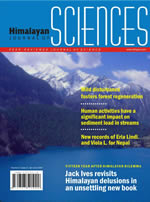Vegetation composition and diversity of Piluwa micro-watershed in Tinjure-Milke region, east Nepal
DOI:
https://doi.org/10.3126/hjs.v2i3.227Keywords:
Forest structure, degradation, species richness, dominanceAbstract
Comparative study of vegetation structure and composition of two forests at Tamafok (TF) and Madimulkharka (MM) villages in the Piluwa micro-watershed was undertaken. A total of 20 tree species were reported, with more species in the non-degraded TF forest than in the degraded MM forest. Rhododendron arboreum and Goldfussia penstemonoides were the dominant species in the TF forest, whereas Quercus semecarpifolia and Rhododendron arboreum were dominant in the MM forest. The total density of trees in the TF forest (756 ha-1) was higher than that at MM (346 ha-1). Similarly, tree basal area in the TF forest (69.8 m2 ha-1) was greater than at MM (56.9 m2 ha-1). Shrub density was also higher in the TF forest than at MM. Diversity indices for both trees (2.61) and shrubs (0.915) in the TF forest showed higher values in comparison to MM (2.4, 0.854). Concentration of dominance of the tree species was stronger in the MM forest (0.266) as compared to TF (0.258). The regeneration potential was higher in the degraded MM forest than in the relatively undisturbed TF forest. Seedling-sapling density was lower in undisturbed and mature forest which had closed canopy. Key words: Forest structure, degradation, species richness, dominance Himalayan Journal of Sciences 2(3): 29-32, 2004Downloads
Download data is not yet available.
Abstract
1181
PDF
946
Downloads
How to Cite
Koirala, M. (2006). Vegetation composition and diversity of Piluwa micro-watershed in Tinjure-Milke region, east Nepal. Himalayan Journal of Sciences, 2(3), 29–32. https://doi.org/10.3126/hjs.v2i3.227
Issue
Section
Research Papers




